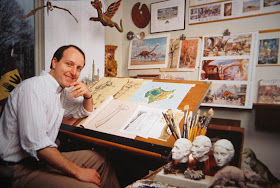I believed that the book should have enough scope to feel like a novel, and should be no shorter than 160 pages, fully illustrated with color on every page. This sort of “long-form picturebook,” was pioneered by the Dutch illustrator Rien Poortvliet (with Wil Huygen) in Gnomes

Producing that much artwork would mean that I would have to cut myself off from all my freelance illustration clients. My wife, our two little boys, and I would have to survive on the sale of art prints and originals until the book was published.
Seaside Romp, 1990
I had about a hundred and fifty paintings to complete in about two years. A few of the paintings could serve double duty, both as book illustrations and as art print subjects. Those keynote images had to be larger and more finished, and they also had to stand alone outside of the narrative.

The longer form gave me plenty of scope to develop the fantasy. It was five times the length of a typical thirty-two page children’s picture book. It wasn’t like a graphic novel, because each page had only one or two images, and it didn’t require dialog and word bubbles to tell the story.

Storyboard: Will learns to Write
The running text could be a mix of narration, description, and dialog. The text didn’t have to match the pictures exactly. The pictures could provide side excursions into details of the world.
I felt that the illustrated book medium, since it allowed the reader to skip around or pause on a single image, lent itself to a mode of conjuring that could be found in no other medium.

Storyboard: Code of Dinotopia
I wanted to depart from the good-versus-evil dramatic formula that motivated most fantasy universes in literature and film. I knew there must be other ways to set up an imaginary world.
I read more deeply in Irish and Italian folktales, which are full of whimsy and tricksters. I reread other fantasies that I had loved as a child, such as Gulliver’s Travels, The Wonderful Wizard of Oz, and Alice in Wonderland. Those stories inspired me with their fantastic invention and episodic plot lines.
Read More at these Links:
-----
The new official Dinotopia website
Purchase a signed 20th Anniversary Edition of Dinotopia: A Land Apart from Time
----
Gnomes by Poortvliet and Huygens
Noah's Ark by Poortvliet
------
"Origins of Dinotopia" series on GurneyJourney:
Part 1: Childhood Dreams
Part 2: College Obsessions
Part 3: Lost Empires
Part 4: Dinosaurs
Part 5: Treetown
Part 6: The Illustrated Book
Part 7: Utopias
Part 8: Building a World
Part 9: Words and Pictures
Part 10: Canyon Worlds
Part 11: Putting it Together
Part 12: Book Launch


James, Thanks for including some conversation about the practical, financial aspects of the choices you made during your project. It helps to see that even a successful artist had tougher times.
ReplyDeleteThere is a seeming inevitability about 'final products', and we are tempted to think they were conceived all at once, in full.
ReplyDeleteIt is interesting to see this book came about through chance encounters, changes of mind, and your diverse life experiences.
Isn't just great to have a dream, a vision?
ReplyDeleteJames, I echo Ledeaux's and Brueggert's comments. It's very instructive to learn that these projects don't spring fully formed from your forehead, and that they involve struggles and the willingness to take chances - not to mention a supportive and understanding family!
ReplyDeleteA question: are the three sculpted heads next to your drawing table related to Dinotopia, or some other project? Are they your own work?
Tom, those are little plaster heads that I cast from clay originals that I made, long before Dinotopia, (and long before I knew of Sculpey). They're standard reference heads.
ReplyDeleteI really admire and appreciate all of the hard work that went into the making of this book; just as it was inspired by what you read as a child, Dinotopia in turn inspired me in my childhood.
ReplyDelete